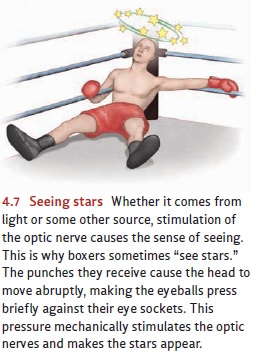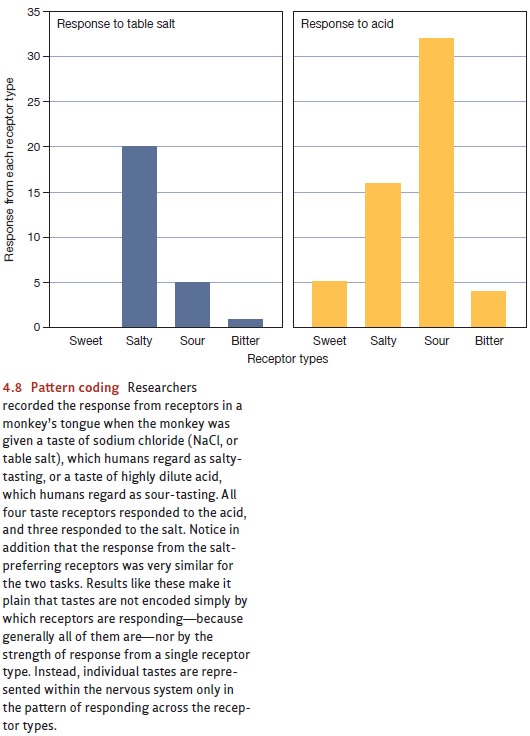Chapter: Psychology: Sensation
A Survey of the Senses: Sensory Coding
Sensory Coding
Each of the sense modalities has
its own properties and follows its own rules. For some modalities (vision,
hearing, taste, and smell), we have specialized organs that collect,
concentrate, and amplify the incoming stimulus information. In other cases (the
vari-ous skin senses), we simply accept the input, unamplified, as it arrives.
For some senses, the crucial input consists of some form of energy—a mechanical
push against the eardrum in the case of hearing; a photon striking the back of
the eyeball for vision. For other senses, the key input is chemical—a molecule
on the tongue or in the nose. Some senses (vision, hearing, smell) can respond
to stimuli that are far away from us; others (touch, taste) respond only to
nearby inputs.
Even with these differences, the
various senses have some crucial features in com-mon. In all cases, the
physical stimulus must be converted into a neural signal; this is the step of transduction. Then, once the stimulus
is transduced, the nervous system needs somehow to represent the various
qualities of the input. At the coarsest level, the nervous system must register
the fact that we saw the pizza but did not taste it, or that we heard the
approaching car but did not see it. What’s more, the nervous system must
somehow represent differences within each sensory system—that the pizza was
salty, not sweet; or that the car was remarkably loud. These are all issues of sensory coding— how the qualities of
the input are translated into specific representations within the nervous
system.
One aspect of sensory coding
involves psychological intensity—the
difference between a bright light and a dim one, or a subtle scent of cinnamon
in contrast to a dense cloud of the smell. In most cases, the nervous system
codes stimulus intensity via the rate of firing by the neurons in a sensory
system: the more intense the stimulus, the greater the rate of firing. Stimulus
intensity is also encoded via the sheer number of neurons that are triggered by
the stimulus: the more intense the stimulus, the more neurons it acti-vates,
and the greater the psychological magnitude.
The second aspect of coding is sensory quality—how the nervous system
represents the difference between, say, vision and hearing; or within a
modality, how it represents the difference between, for example, a high-pitched
note and a low one, or the differ-ence between a sweet taste and a bitter one.
The first of these sensory quality issues— the difference between modalities—is straightforward. Almost 200 years ago,
Johannes Müller argued that the key lies simply in which nerves are being stimulated.
Stimulation of the optic nerve (whether from light or some other source) causes
the sense of seeing; this is why strong pressure on the eyeballs leads us to
see rings or stars (to the dismay of boxers and the delight of cartoonists;
Figure 4.7). Similarly, stimulation of the auditory nerve—whether it’s from a
sound or something else— causes the sense of hearing. This is why people
sometimes experience “ringing in their ears” in the absence of any
environmental sound—some illness or injury is causing stimulation of the
auditory nerve.

What about differences within a sense modality? For example,
blue, green, and red are all visual sensations, so they all involve activity in
the optic nerve. But of course each color is qualitatively different from the
others. Likewise, sweetness and saltiness are both tastes; but they’re plainly
distinct for the perceiver. How are differences like these encoded? One
hypothesis stays close to Müller’s insight and is often referred to as specificity theory. This proposal
suggests that different sensory qualities (sweet versussour, red versus green)
are signaled by different neurons, just as the different sense modalities
(vision versus pressure) are signaled by different nerves. In this conception,
the nervous system acts as if these quality-specific neurons were somehow
“labeled” with their quality, so that the nervous system registers the presence
of “red” whenever there’s an incoming signal in the “red neurons,” registers
the presence of “hot” whenever there’s a signal coming from the “hot neurons,”
and so on.
This proposal turns out to be
correct in some cases—for example, specific neurons do seem to convey the
sensation of pain. More commonly, though, the data demand a different
explanation—usually called pattern
theory (Figure 4.8). According to this view, what matters for sensory
quality is not which neurons are firing. Instead, what allows us to identify
the input is the overall pattern of
activation—which neurons are firing more, and which less, at any given moment.

We’ll have much more to say about
pattern theory in our discussion of the specific modalities. For now, let’s
just note that there’s no single answer to the question of how sensory coding
is achieved. The difference among senses (e.g., taste versus sight, hear-ing
versus smell) is certainly signaled by “labeled lines,” so activity in the
optic nerve causes the sensation of seeing, activity in the auditory nerve
causes the sensation of hearing, and so on. Some specific sensations (e.g.,
pain) may also be signaled by labeled lines; but more commonly, the nervous
system uses a pattern code to distinguish the qualities within each sensory
modality.
Related Topics